Create portable, custom editor settings with EditorConfig
Applies to: ![]() Visual Studio
Visual Studio ![]() Visual Studio for Mac
Visual Studio for Mac
Note
This article applies to Visual Studio 2017. If you're looking for the latest Visual Studio documentation, see Visual Studio documentation. We recommend upgrading to the latest version of Visual Studio. Download it here
You can add an EditorConfig file to your project or codebase to enforce consistent coding styles for everyone that works in the codebase. EditorConfig settings take precedence over global Visual Studio text editor settings. This means that you can tailor each codebase to use text editor settings that are specific to that project. You can still set your own personal editor preferences in the Visual Studio Options dialog box. Those settings apply whenever you're working in a codebase without an .editorconfig file, or when the .editorconfig file doesn't override a particular setting. An example of such a preference is indent style—tabs or spaces.
EditorConfig settings are supported by many code editors and IDEs, including Visual Studio. It's a portable component that travels with your code, and can enforce coding styles even outside of Visual Studio.
When you add an EditorConfig file to your project in Visual Studio, new lines of code are formatted based on the EditorConfig settings. The formatting of existing code isn't changed unless you format the document (Edit > Advanced > Format Document or Ctrl+K, Ctrl+D in the default profile). Formatting the document only affects white-space settings, such as indent style, unless you've configured Format Document to perform additional code cleanup.
You can define which EditorConfig settings you want Format Document to apply on the Formatting options page.
Note
This topic applies to Visual Studio on Windows. For Visual Studio for Mac, see EditorConfig in Visual Studio for Mac.
Code consistency
Settings in EditorConfig files let you maintain consistent coding styles and settings in a codebase, such as indent style, tab width, end of line characters, encoding, and more, regardless of the editor or IDE you use. For example, when coding in C#, if your codebase has a convention to prefer that indents always consist of five space characters, documents use UTF-8 encoding, and each line always ends with a CR/LF, you can configure an .editorconfig file to do that.
Coding conventions you use on your personal projects might differ from those used on your team's projects. For example, you might prefer that when you're coding, indenting adds a tab character. However, your team might prefer that indenting adds four space characters instead of a tab character. EditorConfig files resolve this problem by letting you have a configuration for each scenario.
Because a file in the codebase contains the settings, they travel along with that codebase. As long as you open the code file in an EditorConfig-compliant editor, the text editor settings are activated. For more information about EditorConfig files, see the EditorConfig.org website.
Note
Conventions that you set in an EditorConfig file can't currently be enforced in a CI/CD pipeline as build errors or warnings. Any style deviations appear only in the Visual Studio editor and Error List.
Supported settings
The editor in Visual Studio supports the core set of EditorConfig properties:
- indent_style
- indent_size
- tab_width
- end_of_line
- charset
- trim_trailing_whitespace
- insert_final_newline
- root
All Visual Studio-supported languages except for XML support EditorConfig editor settings. Also, EditorConfig supports code style conventions including language, formatting, and naming conventions for C# and Visual Basic.
Add and remove EditorConfig files
When you add an EditorConfig file to your project or codebase, any new lines of code you write are formatted according to the EditorConfig file. However, adding an EditorConfig file doesn't convert existing styles to the new ones until you format the document or run Code Cleanup. For example, if you have indents in your file that are formatted with tabs and you add an EditorConfig file that indents with spaces, the indent characters aren't automatically converted to spaces. When you format the document (Edit > Advanced > Format Document or Ctrl+K, Ctrl+D), the white-space settings in the EditorConfig file are applied to existing lines of code.
If you remove an EditorConfig file from your project or codebase and you want new lines of code to be formatted according to the global editor settings, you must close and reopen any open code files.
Add an EditorConfig file to a project
Open a project or solution in Visual Studio. Select either the project or solution node, depending on whether your .editorconfig settings should apply to all projects in the solution or just one. You can also select a folder in your project or solution to add the .editorconfig file to.
From the menu bar, choose Project > Add New Item, or press Ctrl+Shift+A.
The Add New Item dialog box opens.
In the search box, search for editorconfig.
Two editorconfig File item templates are shown in the search results.
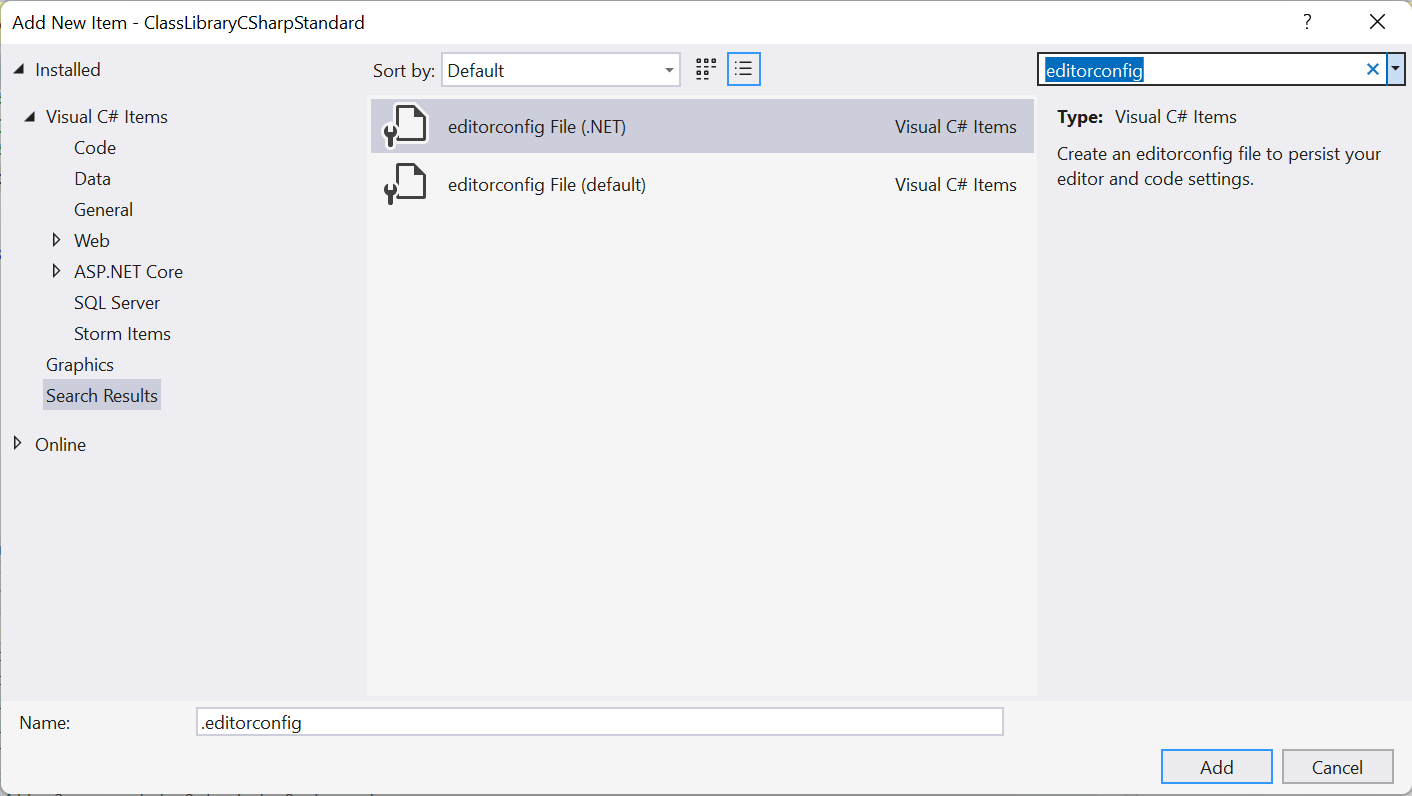
Select the editorconfig File (default) template to add an EditorConfig file prepopulated with two core EditorConfig options for indent style and size. Or, select the editorconfig File (.NET) template to add an EditorConfig file prepopulated with default .NET code style, formatting, and naming conventions.
An .editorconfig file appears in Solution Explorer, and it opens in the editor.
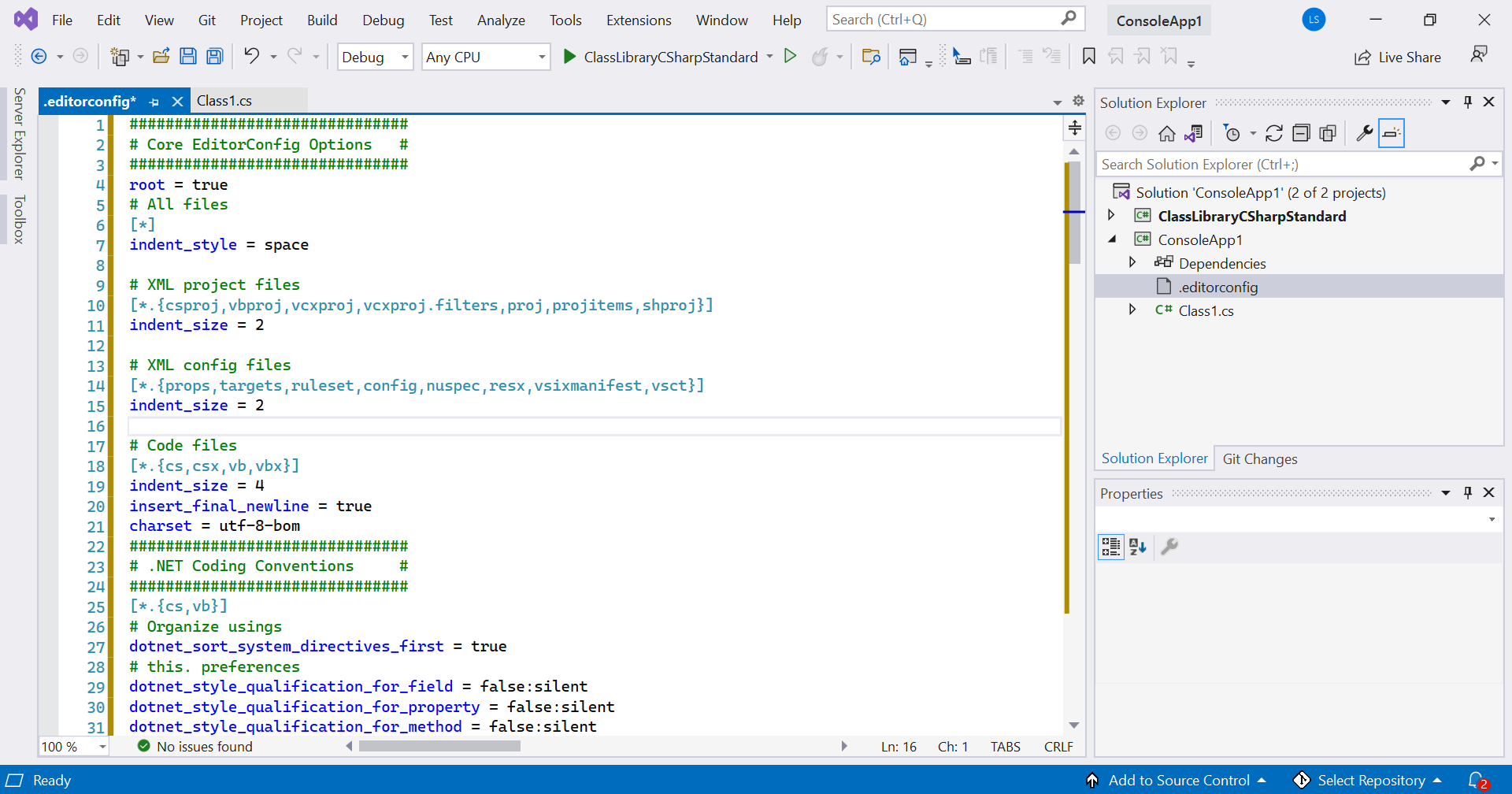
Edit the file as desired.
Other ways to add an EditorConfig file
There are a couple of other ways you can add an EditorConfig file to your project:
The code inference feature of IntelliCode for Visual Studio infers your code styles from existing code. It then creates a non-empty EditorConfig file with your code-style preferences already defined.
Starting in Visual Studio 2019, you can generate an EditorConfig file based on your code-style settings in Tools > Options.
File hierarchy and precedence
When you add an .editorconfig file to a folder in your file hierarchy, its settings apply to all applicable files at that level and below. You can also override EditorConfig settings for a particular project, codebase, or part of a codebase, such that it uses different conventions than other parts of the codebase. This can be useful when you incorporate code from somewhere else, and don’t want to change its conventions.
To override some or all of the EditorConfig settings, add an .editorconfig file at the level of the file hierarchy you want those overridden settings to apply. The new EditorConfig file settings apply to files at the same level and any subdirectories.
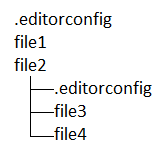
If you want to override some but not all of the settings, specify just those settings in the .editorconfig file. Only those properties that you explicitly list in the lower-level file are overridden. Other settings from higher-level .editorconfig files continue to apply.
If you want to ensure that no settings from any higher-level .editorconfig files are applied to this part of the codebase, add the root=true property to the lower-level .editorconfig file:
# top-most EditorConfig file
root = true
EditorConfig files are read top to bottom. If there are multiple properties with the same name, the most recently found property with that name takes precedence.
Edit EditorConfig files
Visual Studio helps you edit .editorconfig files by providing IntelliSense completion lists.
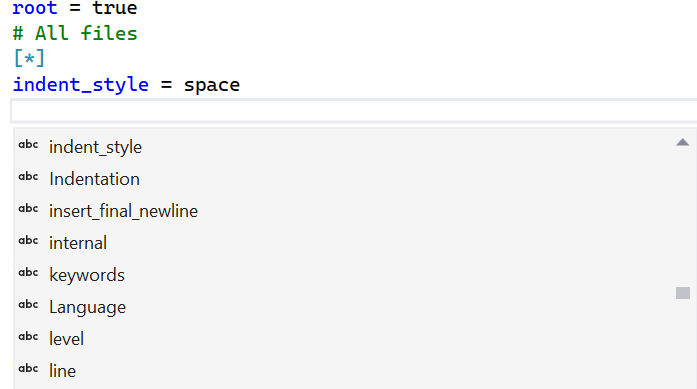
After you've edited your EditorConfig file, you must reload your code files for the new settings to take effect.
If you edit many .editorconfig files, you might find the EditorConfig Language Service extension helpful. Some of the features of this extension include syntax highlighting, improved IntelliSense, validation, and code formatting.
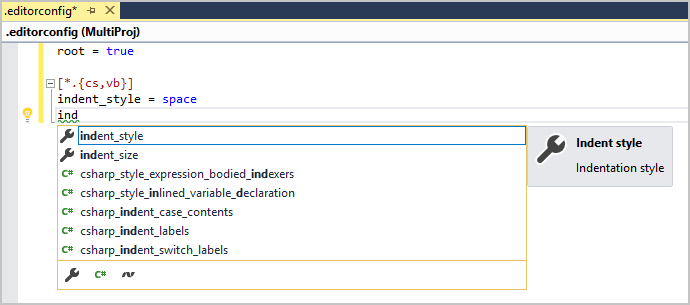
Example
The following example shows the indent state of a C# code snippet before and after adding an .editorconfig file to the project. The Tabs setting in the Options dialog box for the Visual Studio text editor is set to produce space characters when you press the Tab key.
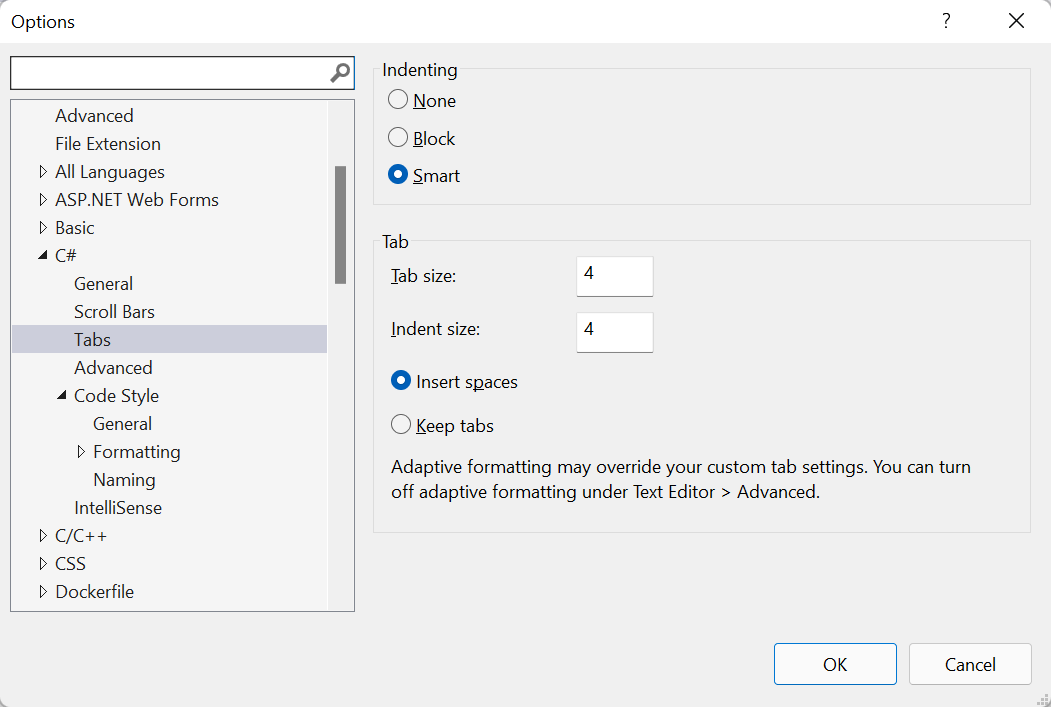
As expected, pressing the Tab key on the next line indents the line by adding four more white-space characters.
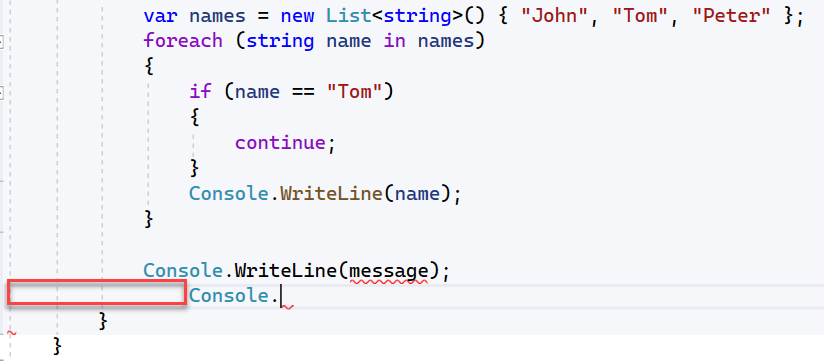
Add a new file called .editorconfig to the project, with the following contents. The [*.cs] setting means that this change applies only to C# code files in the project.
# Top-most EditorConfig file
root = true
# Tab indentation
[*.cs]
indent_style = tab
Now, when you press the Tab key, you get tab characters instead of spaces.
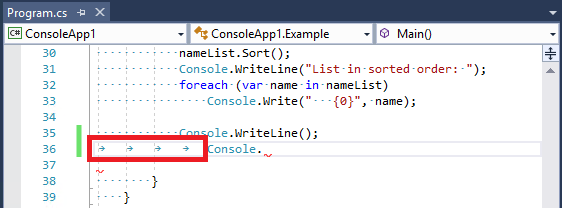
Troubleshoot EditorConfig settings
If there is an EditorConfig file anywhere in the directory structure at or above your project's location, Visual Studio applies the editor settings in that file to your editor. In this case, you might see the following message in the status bar:
"User preferences for this file type are overridden by this project's coding conventions."
This means that if any editor settings in Tools > Options > Text Editor (such as indent size and style, tab size, or coding conventions) are specified in an EditorConfig file at or above the project in the directory structure, the conventions in the EditorConfig file override the settings in Options. You can control this behavior by toggling the Follow project coding conventions option in Tools > Options > Text Editor. Unchecking the option turns off EditorConfig support for Visual Studio.
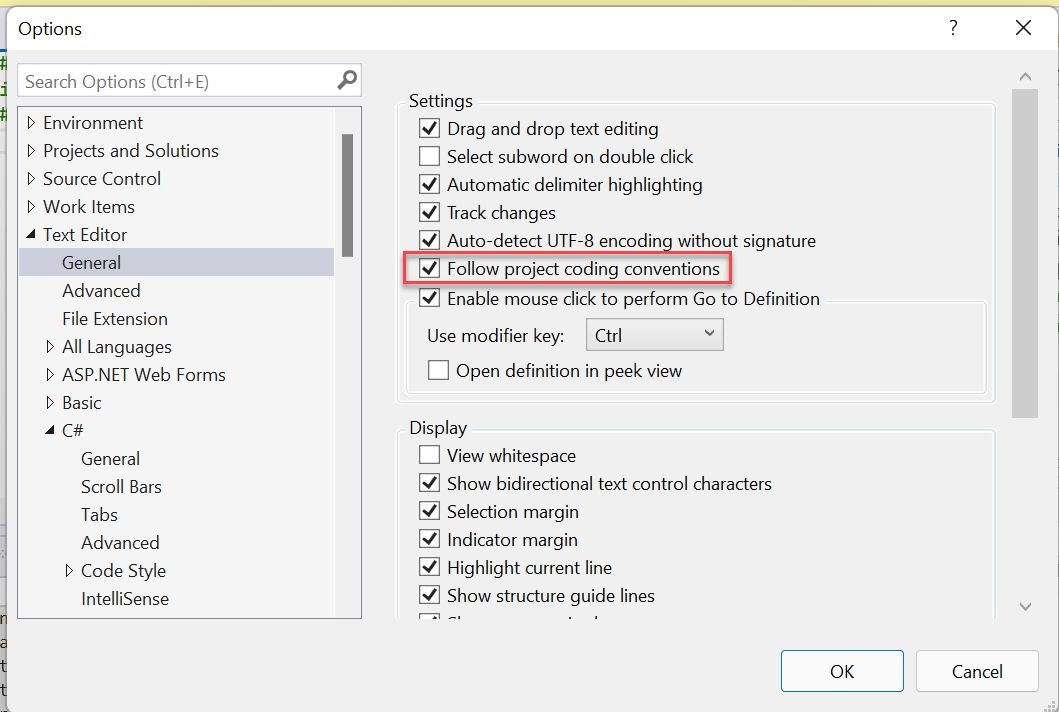
You can find any .editorconfig files in parent directories by opening a command prompt and running the following command from the root of the disk that contains your project:
dir .editorconfig /s
You can control the scope of your EditorConfig conventions by setting the root=true property in the .editorconfig file at the root of your repo or in the directory that your project resides. Visual Studio looks for a file named .editorconfig in the directory of the opened file and in every parent directory. The search ends when it reaches the root filepath, or if an .editorconfig file with root=true is found.